Lisa Niver's Blog: We Said Go Travel, page 344
December 25, 2014
Costa Rica – Pura Vida en Monteverde
 To those who have visited,Costa Rica embodies the idea of a simple lifestyle and easy living, or as the locals say, Pura Vida. But for me, the true spirit of Costa Rica was not found at its sandy beaches, but up high in its mountains and cloud forests. Away from the crowds, removed from the noises, I found a sense of Pura Vida in a place called Monteverde, from a most unexpected group.
To those who have visited,Costa Rica embodies the idea of a simple lifestyle and easy living, or as the locals say, Pura Vida. But for me, the true spirit of Costa Rica was not found at its sandy beaches, but up high in its mountains and cloud forests. Away from the crowds, removed from the noises, I found a sense of Pura Vida in a place called Monteverde, from a most unexpected group.
To many Costa Ricans, Monteverde is a bit of an enigma, maybe even a little confusing. Aside from the locals who’ve been there since the time immemorial, in this remote region in Central America, abundant in resources with 6% of the world’s biodiversity, quietly resides a vibrant Quaker community.
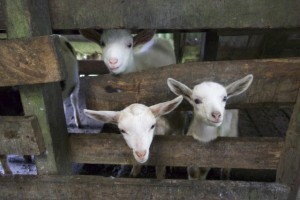
The goats on Benito’s dairy farm
In the 1950’s, a small population of Quakers from Fairbanks, Alabama, in order to escape the violent social environment brought on by the Korean War, immigrated to Costa Rica. They brought with them the age-old practice of dairy farming as a means of income as well as a vision of a society founded on the principles of Peace, Equality, Simplicity, and Truth. Now, sixty years later, the community has not only planted its roots deeply in this area, but has helped transformed Monteverde into an internationally renowned destination for ecological tourism and research.
We were fortunate enough to have been introduced to this community and was invited to attend a Sunday meeting. Not being familiar with the Quaker ways, many of the activities we observed were fascinating. This society of “friends”, as they call their members, holds a social structure so lacking in hierarchy it looks almost anarchistic. A consensus is reached, but not by explicit voting. Instead, it’s an implicit agreement of group feeling the Quakers call “sense of the meeting”. There is no person or group with executive power, only administrative abilities to make sure the decisions are carried out.
The emphasis on equality permeates throughout every aspect of the community. Instead of a governing body, there are committees; instead of elected leaders, there are clerks and overseers, whose main job is to end assemblies when they run for too long. There are no debates that determine courses of action for the community, instead there are “meetings”, where no one is obligated to speak, and in between speakers it is common to have a minute or two of silence for people to reflect. The clerks and overseers are not chosen based on an electoral process, but instead by appointments of three years cycles, usually to people actively involvements in the community.
In a world where it’s routine to see leaders pander to their constituents, where complex problems are reduced to catch phrases devoid of all nuisances, where people are often either too apathetic or too cynical about government to want to participate, a society of “friends” whose idea of a policy debate is a two hour meeting where one hour is spent sitting in silence seems almost comically out of place. Yet, decisions are made in a timely manner, each person’s opinions are equally respected, and no one feels the pressure to conform to ideas shouted by loud and obtrusive individuals. Amongst Monteverde’s strikingly beautiful landscape and surprisingly cool weather, the Quakers have lived a quiet, peaceful lifestyle since their first establishment. Their traditions and values may have evolved over the years, but the core remains intact.
The Costa Rican phrase of Pura Vida carries with it a longing for simplicity. As one puts it, “Eat well, sleep well, shit well, that’s it.” Yet, as tourism boomed, so too did these words change from a cultural adage describing a way of living to a catch phrase used to entice and entertain. Today, the Pura Vida lifestyle is hardly seen in San Jose or Tamarindo. There, I see the same hustle and bustle as any other big cities and popular tourist destinations. It’s hard to argue with economic development, but it’s even harder to get what Pura Vida really means standing next to a sign for Black Friday. The cloud forest of Monteverde was an escape, and the people there made it a more than memorable one.
Click here to watch our Million Ways to Live episode at Benito’s farm from Monteverde!
The post Costa Rica – Pura Vida en Monteverde appeared first on We Said Go Travel.
#MyDanaPoint: Dine at Raya, The Ritz Carlton Laguna Nigel
#MyDanaPoint: Dine at Raya, The Ritz Carlton Laguna Nigel
I loved my dining experience at Raya and then exploring the mile of Holiday Lights at IlluminOcean!
A photo posted by Lisa Niver (@wesaidgotravel) on Dec 12, 2014 at 6:37pm PST
Delightful Dining @ritzcarlton #RCLagunaNigel great company, food & location. #MyDanaPoint A photo posted by Lisa Niver (@wesaidgotravel) on Dec 12, 2014 at 6:47pm PST
A photo posted by Lisa Niver (@wesaidgotravel) on Dec 12, 2014 at 7:10pm PST
Cinnamon Churros with chocolate ginger spice cream chocolate caramel sauce, chocolate-banana cake with sriracha crackerjack and buttermilk ice cream, carrot cake with cream cheese ice cream, and vanilla flan and apple fritters #MyDanaPoint #RCLagunaNigel @ritzcarlton #outstanding #marvelous #IWillBeBack! A photo posted by Lisa Niver (@wesaidgotravel) on Dec 12, 2014 at 10:30pm PST
A photo posted by Lisa Niver (@wesaidgotravel) on Dec 12, 2014 at 5:33pm PST
VIDEO: IlluminOcean Dana Point Holiday Lights 2014
The post #MyDanaPoint: Dine at Raya, The Ritz Carlton Laguna Nigel appeared first on We Said Go Travel.
December 24, 2014
I am Unstoppable and I Love Orange Soda.USA

I am Unstoppable and I Love Orange Soda
People can say what they will about Philadelphia. As a North Jersey college student, my peers have written it off as “A downgraded New York,” or “a dump with nowhere to park.” Still, in the City of Brotherly Love, brotherly love accounts for most of my finds. The first of them was the most important- a cup of orange soda that changed my life.
Pat and I have known each other since pre-school, and now both of us are in college. We met Jon much later, but the three of us grew close almost instantly. Jon’s presence here is important. The man is a bona fide gentleman. Seeing him argue is a rare sight, and even at his worst, he understands his feelings well enough to articulate them well.
The three of us were headed for a Japanese restaurant in the city. When we found a sense of the time, it was edging a bit past 9:30, and the restaurant would close at ten. Getting hungry and having already hyped myself for sushi, I was a bit irritated by the confirmation that making it was out of the question. To make matters worse, we had forgotten where Pat had parked. Disappointed, I turn to my first instinct and bottle it up. It surfaces minutes later, when we come across a cat.
I have a certain love/hate relationship with cats. I adore the ones that grow on me, but this was years ago. My only real experience was with my cousin’s cat, Mickey (I have a special distaste for that creature). Jon takes note of the cat and approaches it. Peeved, I raise my voice and say, “Jon, we don’t have time.” His response put the first crack in my worldview.
“Do we really not have time?”
It comes off stern, perhaps with a touch of iron, but there is no unnecessary aggression. Now catching myself, I apologize immediately.
Giving up on our original plan, we explore the city. To hold us over, we stop into a corner store and each grab an orange soda. The pearl of wisdom I left with that night set in when the orange soda healed me.
Soda is hardly the healthiest thing in the world, but I felt refreshed. Without the thirst and the lukewarm feeling in my gut, I was able to focus on what mattered: good company. With that in mind, I realized that I was, contrary to popular adages, sweating the small stuff. Crying over spilled milk. No more.
Eventually, we stumbled upon a sandwich shop- the sign said it was closed, but the door was open. The owner appeared to be working the store, with a cashier at the counter. Both were bright and friendly, and the fact that it was open overtime seemed to be just because they liked working there enough to work longer. The same way the orange soda set the tone for that night, that encounter in the store set the tone for Philly.
We found Pat’s car, and we even got in touch with our friend Jamey, grabbing dessert at his restaurant toward the end of his night shift. Coming upon two new favorite places to eat in three hours, I could count this as a good night. Passing time in the foyer of his apartment complex, we found ourselves talking about whatever crossed our minds until we left at four in the morning.
A good adventure may not always call for traveling far, and even a meaningful adventure can lack the conflict and danger of a classic swash buckler movie. No one can afford to let every little thing ruffle their feathers, and since that night in the city, I find myself stronger, wiser, and (most importantly) happier.
Thank you for reading and commenting. Please enter the Gratitude Travel Writing competition and tell your story.
The post I am Unstoppable and I Love Orange Soda.USA appeared first on We Said Go Travel.
Mabuhay: A Look Born in the Philippines
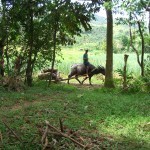
Mabuhay: A Look Born in the Philippines
My husband has a certain look. He gets that look whenever he talks with someone who knows, like he does, what it meant to live in the Philippines. It is a look of tested peace, a hidden crucible of understanding that connects those who have experienced it. He spent two years as a religious missionary in the areas surrounding Bacolod and Iloilo and spoke Ilonggo, a local dialect. For me, my husband’s look has a slightly different meaning. It signifies the Philippines and what the Philippines became to me. That meaning took on greater significance when I went back with him a few years later to keep a promise he had made that he would go back. A promise that brought tears into the eyes of one matriarch of a family who lived on the top of a mountain. She had remembered his promise, and he had fulfilled it.
The Philippines first became a place that helped me become strong and hopeful because it connected me to a dear friend. Yes, it is the place that separated me physically from that person, who later became my husband, for a time, but it also uniquely connected us as we wrote letters every week, sharing experiences from our separate sides of the globe. I truly grew to love and appreciate the Philippines; simply thinking about it brought joy and a smile to my face. It is appropriate that Bacolod City is called the City of Smiles. Whenever I would meet someone from the Philippines at that time, I got excited and talked about things such as balut (a Filipino delicacy), and asked where they were from, hoping that they might be from areas close to Bacolod City or Iloilo. I laughed at some of the experiences my friend wrote to me, such as how he and another American, both tall redheads, were walking through a remote area of the bukid (mountain) and came across a child. The child screamed and ran from them in terror, having never seen the strange sight of two tall, white-skinned redheads. My own heart jumped as I read about the typhoon that whipped through an area he was in, changing the face of the land, and creating rivers that almost swept him away never to return.
But he returned, we were married, and a few years later, we went on a trip to the Philippines, where I was able to see for the first time the places he had written me about and meet the people he came to love. It deepened my understanding and love that I already had for that place. We traveled along the beautiful coast, visited spectacular beaches, and rode up a mountain on the back of a motorcycle to a small village. We haggled with vendors. We sat in a classroom and laughed with Filipino teenagers as they tried to make the sound of a Gecko as “gecko” because their word for the same type creature was “Toco” because it made the sound “toco.” We rode jeepneys in the city. We got caught in a deluge of rain near a sugar cane field as our tricycle driver tried to race down a bus we needed to get on. We saw about 20 people riding a tricycle meant for 3 passengers. We saw a large black spider that was about twice as big as my hand hanging in a tree above me. The family with us at the time laughed and said the spider was “delikado,” or dangerous, and then proceed to play with it. On our way to Mambukal, a beautiful waterfall tourist attraction, we approached a completely packed vehicle, ready to jump on the back and hang on like many Filipinos, but we were ushered to the very front seat, displacing other passengers, to sit next to the driver as if we were celebrities.
Yes, the Philippines is a place of strength and hope for me. Before I loved it for what it signified between me and my husband, but now it is even dearer because we’ve experienced it together. I’ve been to the places I read about. I’ve talked to the people and seen their humble lives. I’ve tasted a mango from Guimaras. I’ve ridden on the back of a caribou. I’ve eaten fresh coconut harvested with a machete. It is our place not only because of the connection it signifies between us, but now the connection it has with us. Filipinos have a greeting, “Mabuhay,” which, in Tagalog, is literally the imperative form of “live.” To live is to bring together knowledge, understanding, and experience. My husband knew what it was like to live in the Philippines. My experience with the Philippines helped me better know what it means to “live.”
Thank you for reading and commenting. Please enter the Gratitude Travel Writing competition and tell your story.
The post Mabuhay: A Look Born in the Philippines appeared first on We Said Go Travel.
The Place Where I Can Be My Own Hero. New Zealand
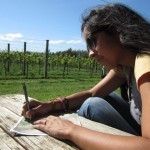
I took a big risk to journey to New Zealand. I left a steady job and paycheck. I had a fabulous Brooklyn apartment and a sexy social life. I craved the spontaneity in life and wanted to solve my personal mystery of the other side of the world. I went to get lost in myself. Without that adventure, I wouldn’t be where I am today– a hero in my own right. I battled the ugly monster of self-doubt and prepared to take that battle to the depths of Middle-Earth.
I’ve always been hard on myself– constantly measuring myself up to others. In New York City, I found that the world’s best employees compete at their profession, almost as if for sport. I thrived off of that indescribable energy running under the island of Manhattan. I have aspirations just like anyone but I didn’t think another winter in New York would inspire me enough to truly pursue a passion in writing. Deep down, I knew another island was where my heart belonged.
New Zealand has something for everybody. From it’s rolling Hobbit-hills and bounty of sheep-strewn countrysides, to it’s crystal clear waters and sky-high mountain peaks, it’s a special spot reserved for those who want to be challenged on many levels. Deep in the grapevine-lined streets of Martinborough, a rush of gratitude and pride came over me as I rode my bike rental to a tasting. I looked around and felt as if there were stories to tell behind every vineyard, every pebbled pathway, in every sommelier we met, in every grapevine we touched. The stories were endless and I wanted to capture them and share them with others. I couldn’t stop documenting the trip, mapping the routes to the next vineyard while describing every note on my tongue. I took countless photos to remember the moment that I went to the far ends of the Earth to find my new beginning.
I found a special place within. I prided myself on taking a leap of faith to do something different. There, I wrote my first novel, I designed and sold jewelry at a local holiday market, and I opened a micro coffee roastery with my partner. I took all my bottled up energy to New Zealand to gain perspective. Some think it sounded like a big vacation, but it wasn’t easy. I certainly enjoyed the outdoors but I had one goal in mind– to let my creative juices flow and see where it took me. These special places in New Zealand opened my eyes to a new world of beauty that inspired me to do anything. I was my own hero finally. I stood up to the doubts from family and friends and took a risk that has set the stage for a happy life. I realized I had enough courage to be who I wanted to be– a wanderlust writer with a heavy dose of Frida Kahlo influence and a ferociously driven woman who gained comfort and a new confidence from the South Pacific.
Thank you for reading and commenting. Please enter the Gratitude Travel Writing competition and tell your story.
The post The Place Where I Can Be My Own Hero. New Zealand appeared first on We Said Go Travel.
The Lowdown on High Tea: Eating in Britain
Let’s talk about British food. I mean, let’s really talk about British food. It’s got a terrible reputation. If you visit, what are you going to find?
Breakfast: Every B & B I’ve ever stayed at offered a full English breakfast—or full Scottish or Irish or Welsh breakfast. In Cornwall, where I live, it’s still, mysteriously, called the full English, although the Cornish aren’t given to calling themselves English. Whatever it’s called, though, it includes an egg, a grilled tomato, a sausage, a piece of bacon, a puddle of baked beans, possibly some fried mushrooms, possibly a piece of black pudding, and definitely some toast set in a rack to cool so it won’t, all the gods of breakfast forbid, melt the better.
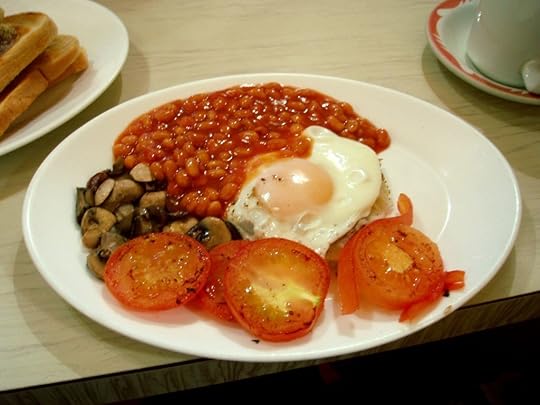
The Full English Breakfast. Photo by Ewan Munro, from Wikimedia Commons.
Maybe you have to be born here to love it. It’s heavy and although it isn’t always greasy, it tends to be. It’s also one hell of a lot of food. And on a personal note, I hate baked beans. Especially for breakfast. But if you stay at a B & B, it’s included in the price, so if you’re short on money you’ll eat it. It’ll keep you going till late in the day. If money isn’t tight, you can ask for just one or two items—toast and eggs, maybe, or a single baked bean and a grilled tomato. Or you can just have cereal. I can’t remember a B & B that didn’t offer that as well.
Lunch: Most lunch places serve soups and sandwiches, which range from good to not-so, and many sell jacket potatoes—what we called baked potatoes in the U.S.—as a lunch. You can get them with just butter or you can add a filling, anything from coleslaw to baked beans (they’re everywhere) to cheese to curry. In Cornwall (or Devon—the counties are fighting a war over who invented them) you’ll find pasties. They’re a meal in themselves, and not a light one. Traditionally, the pasty was a miner’s lunch and it was made of beef, potato, and veggies folded inside a crust, but vegetarian and vegan versions are sold pretty much everywhere. I’ve eaten enough that I’ve started to notice how greasy they are, but you can’t say you’ve visited the southwest unless you’ve tried one, and they are good.
Afternoon Tea: The British really do love afternoon tea. It’s not necessarily fancy—usually just a cup of tea and something baked, and almost anything baked is worth trying. Scones (unless they’re inside a cellophane package) are almost universally good. Cornish (or let’s be generous: Devon) cream tea is magnificent: scones, jam, and a heavy, unsweetened cream called (don’t let the name put you off) clotted cream. Cornwall and Devon can’t agree on who invented the cream tea or on whether to put the jam or the cream on first. My advice? You’re a visitor; do a little of each and avoid offending anyone.
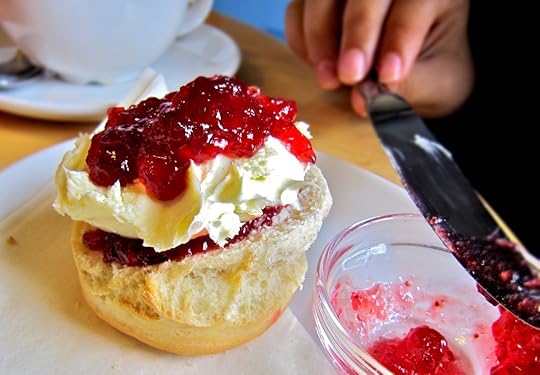
Cream Tea, with Jam on Top and Bottom to Avoid Offending Anyone. Photo by Foowee, from Wikimedia Commons.
Fruit pies are made with a slightly sweet crust. Since I’m American, I’m used to—and actually like—pie crusts that taste like cardboard, but I love the British version. Ginger cake is also wonderful, and coffee cake is actually made with coffee—another surprise for an American, since our coffee cake got its name from being eaten with coffee instead of being made with it. That’s a random sampling. If you can try everything, do.
Evening Meals: These pretty much divide into (a) carryout, (b) ethnic food, (c) pub or, in cities, café food, and (d) restaurant food.
Carryout: In small towns, this will probably be a kebab shop or a fish n’ chip place. In cities, you’ll find a wider range. This is your cheapest option.
Ethnic food: A small and unscientific survey reveals that every town has at least one Indian restaurant. Cities will have a wider range. They’re not necessarily cheap, but many are good.
Pubs and cafes: Pub grub is traditional British food. I wouldn’t say it’ll send you into ecstasy, but it will fill you up. Some pubs have gone high-end and call themselves gastro pubs, with fancier menus and fancier prices. In cities, you may find cafés—informal, lunch-y places—that stay open in the evening and serve evening meals, but in the countryside, where I live, cafes close by late afternoon.
Restaurants: These tend to be fancier than pubs, and pricier. You’ll find menus outside the doors so you can check prices and offerings. Britain’s in the throes of a food revolution and I’m told that some of the high-end restaurants are very good. I’ve never seen the point in spending silly amounts of money on a meal, so I can’t testify on this.
Vegetarian Food: I have yet to find a place that didn’t offer a vegetarian choice, and sometimes a vegan one. It doesn’t always thrill me, but it does fill me up.
Want to read more from Ellen Hawley? Buy her book: The Divorce Diet due out December 30, 2014
The post The Lowdown on High Tea: Eating in Britain appeared first on We Said Go Travel.
December 23, 2014
Big Sur, California: Beauty and Bliss in My Own Backyard
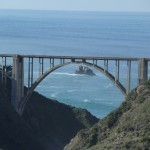
I nearly had a heart attack when I first saw the dazzling captivation in the marine wonderland of coral and iridescent fish off a tiny island in Micronesia. In Bali, I marveled at how the spiritual was so inextricably (and gracefully) woven into everyday life, where everyone I met gave daily flower-filled offerings of gratitude to the gods, and welcomed travelers with open smiles and hearts. Long stays in the Bahamas, in Panama, in Mexico—the people, the food, the vistas, the solid commonness of every day—all delightful.
But that old cliché of happiness being found in your own backyard is so true (as long as you count my backyard as being about 50 miles long). Big Sur is the place that makes me feel both grateful and hopeful, as much for its extraordinary vistas of cliff and sea as for its off-center quirks. Since I live only a bit over an hour away, I’ve been going—several times a year for over 20 years—on what can only be called pilgrimages to Big Sur. Pilgrimages because Big Sur has a presence, a combination of setting and that elusive “vibe” that puts me in a contemplative, appreciative state.
First: consider that setting: whipping around the twists of the Big Sur coastline can stun the eyeballs, where the beauty of some craggy vista can be shocking, where you can only point and say, “Look!” Visitors (and I) can feast on the rich palette of the sea’s deep blues, caught in narrow coves thrashed by waves, or rolling in rhythm over big outcrops of near-shore rocks—there are scenic overlooks aplenty.
But why just look? There’s a concentration of great hikes throughout the Big Sur area, from the quick—though not-so-easy—Partington Cove to some of the “are we still going up?” treks in its several state parks. So many hikes have soaked me with sweat, but so many of those drenchings have been rewarded with breathtaking vistas of those deep blues, or of the cool envelopment of the area’s forests, ripe with wildflowers and wildlife.
There are lots of small shops with unusual handicrafts, and plenty of places to stay, from the over-the-top rustic amazements of Post Ranch Inn to the historic and odd Deetjen’s Inn. Speaking of history, there’s lots: the welcoming, eccentric Henry Miller Library, with its alternative band concerts and artwork-strewn grounds, is an encapsulation of Big Sur consciousness, and a fine tribute to one of the area’s writing luminaries. There’s the architectural sweetness of the old Bixby Bridge and the romantic allure of the older Pt. Sur Lighthouse. Even Richard Burton and Elizabeth Taylor frolicked here during the filming of The Sandpiper, enjoying the good grub and breathtaking views of the entrancing (and aptly named) Nepenthe restaurant.
But it’s the spirit of a place that beguiles—and every place has a spirit. It’s that spirit of succor and refreshment that brings me back over and over again to Big Sur. That spirit is in the smile of a café waitress as much as it’s in the majesty of a timeless view. Big Sur is a place where my smile is ever renewed. I go there for restoration, contemplation, exertion and respite. I’ll never stop going, because Big Sur never stops giving.
Thank you for reading and commenting. Please enter the Gratitude Travel Writing competition and tell your story.
The post Big Sur, California: Beauty and Bliss in My Own Backyard appeared first on We Said Go Travel.
Rhythm of Life in France
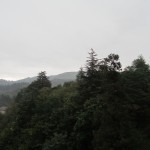
I am alone in the farmhouse. I know I am alone. The farmer left an hour ago. I saw his car disappear along the drive, past the linden trees, over the stream and round the corner into the forest. When I walk down to the kitchen the dog is fast asleep on the mat in front of the fire. The cats are still out hunting. It is 7am.
I brew coffee and sit at the long wooden table. The dog stirs and moves over to lean his great bulk against my leg. Maybe he, too, is feeling the isolation. The clock ticks denting the silence.
I open the door onto the terrace and walk outside. There is a promising crimson glow behind the mountains. A silhouette of trees decorates the horizon. In the valley a grey mist hangs like a shadow. Everything is dripping as if someone is trying to fold tissue paper quietly.
This is the Cevennes, a remote area of southern France. It is a place where tourists patter rather than tramp; where you can think and walk and find a different rhythm of life. Head two hours west of Avignon, climb the winding roads into the mountains and you can walk all day without seeing another soul. No sound of traffic, just the crack of a twig breaking beneath your boot and the trickling of water in the streams.
The Cevennes National Park is the country’s largest wooded national park where golden eagles soar, rock roses and orchids bloom and the most handsome stags in France are found.
Flocks of sheep roam the limestone plateau of the Great Causses in the west with its Atlantic climate, while in the forested eastern Cevennes, the climate becomes Mediterranean as the altitude decreases. Cattle graze on the slopes and sheep are still taken up to high summer pastures. Then to complete the unspoilt landscape, there are river valleys, gorges, grottos and caves.
I am here for two weeks to improve my French and help with the garden.
It turns out that it’s just me and the farmer, Bernard. Bernard’s wife left for a retreat the day before I arrived and will return after I have left. But she is here in spirit. Her messages are all around – on the front door knocker, on the fridge, on the kitchen cupboards. “Who am I today and what grand and glorious adventure will I have.” Another says: “How does it get better than this?” So why did she go I wonder.
I spend the morning cutting lavender. It is like cutting hair, snipping and shaping with scissors. The aroma is intense and hovers over me. Bernard returns late morning and cooks lunch, a soufflé of spinach and cheese and an endive salad.
The promise of good weather does not materialise. Squalls of rain chase in from the south. Great black clouds shroud the hills. Later in the afternoon it clears a little and I take the dog for a walk. We meander through woods along terraced pathways which drop away steeply down ravines to clear streams. It is autumn. The leaves are curled and crisp like burnt toast.
The pathways are covered with spiky shells, like tiny curled hedgehogs, mouths open, spilling out the shiny brown nuts. Sweet chestnut groves cling onto steep slopes.
This sparsely populated areas of France with remote farmhouses and crumbling stone ruins hidden in greenery, has a history of isolation and poverty which has driven the people of these mountains to self sufficiency. Every house has its vegetable garden, often on a shelf of land cut from the hillside.
Man has shaped the landscape over centuries building tiers and terraces and planting trees. Monks played their part too with self sufficiency based on the sweet chestnut, orchards, kitchen gardens, goats, sheep, hens and bees. The sweet chestnut or bread tree as it is known in the Cevennes, has dominated the landscape and sustained generations of people.
It is a land steeped in tradition with a way of life shaped by the environment. It is a special area where old customs and skills have survived over the centuries.
It has a permanence about it which feeds the soul and makes me strong. I know it will draw me back to discover more of its past and enjoy its peaceful present. And maybe next time I will meet the farmer’s wife.
Thank you for reading and commenting. Please enter the Gratitude Travel Writing competition and tell your story.
The post Rhythm of Life in France appeared first on We Said Go Travel.
Cabal, Ethiopia
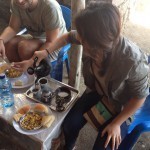
Cabal
Grandpa collected coffee beans like a jewel thief. He could find traders in all the nooks and crannies of Addis, from the roadside shops in Meskel Flower to the huts at the Simien mountain base where the lonely widow hoarded her beans. He would bargain ferociously and always paid much less than he should have, never to be found again. He drove for days across the Ethiopian countryside in a rattling sedan, picking up hitchhikers who told him stories of Jerusalem, Mexico City, and Starbucks. He understood the English, Spanish, and French words like a kid catching the falling Autumn leaves. Sometimes he invited them to try coffee beans that he found along the way. He always brewed it himself. First kindling the fire, then roasting the green beans in a hole grill nut pan. Many people can’t stand the smell of roasting coffee beans, but I grew up loving the heady burnt grass smell that never left my grandpa’s beard. He’d fan the freshroasted beans so that their flaky skin blew up around his face. Then he would cook the coffee in his jebena pot. Thick and black as night. The more sugar you add, the more hospitable you are.
Grandpa gave me his best jebena as a wedding gift. I didn’t tell him that my new bride didn’t like coffee, or else he wouldn’t let have let me marry her. But he did find out the next year, when Helina refused to let him give our baby his first sip of coffee. That was the first of many grudges that Grandpa held against Helina. He accused her of being a South African Anglophile, understanding none of the old customs that brought people together. The French Revolution, he told her, began with coffee. At the Palais Royale in Paris, the intellectuals of the day changed their drink from wine to coffee and sparked the most dynamic conversations of their time. Helina was sick of his history lectures and it became difficult for me to take his side.
Grandpa’s trips to the countryside became longer and longer. His visits fewer and far between. Dawit grew up not knowing any of the history that centred on coffee. I told him at least of the goats that first discovered coffee in our own Ethiopian land. But my tales fell flat without Grandpa’s grassy beard and the hot smoke of new coffee brewing. When we moved to the new house, I discovered that the wedding gift jebena was gone. I wondered which American or French tourist was now drinking coffee from mine—from Grandpa’s—favourite jebena. Would Grandpa tell them stories of me? I grew out of the habit of drinking coffee because it no longer came with tales of Grandpa’s sourcing conquests, his brewing innovations. The starry excitement of hearing his sedan rattling in the middle of the night and getting up in my pyjamas to try new beans from Arba Minch. I learnt of coffee’s bitterness for the first time. It was like an old muscle I forgot to exercise. Ten years later, I heard of Grandpa’s death from abroad.
Thank you for reading and commenting. Please enter the Gratitude Travel Writing competition and tell your story.
The post Cabal, Ethiopia appeared first on We Said Go Travel.
December 22, 2014
Pine Forest Enugu: A Home to the Weary and a Haven for the Troubled

PINE FOREST ENUGU: A HOME TO THE WEARY AND A HAVEN FOR THE TROUBLED
The challenges of life and the responsibility attached to our societal position usually confer on every individual a dual personality. There is the public persona, the one the public knows and associates with; and there is the inner person, who steers the ‘ship’ while remaining largely invisible to the public eyes, and comprises the fear, doubts and strength of the individual—which is the very essence of the individual. For instance, in Africa where it is considered a sign of weakness for a man to cry, most men wear a hard face and toughen up when in pain, all in a bid to sell the notion that they are not fragile and are mature to the public, but when alone, these men actually grovel in pain and cry. In another illustration, responsibility to the church could make a pastor or preacher wear a smile all the time, even when they are hurting and are emotionally disturbed. The need to maintain always a certain demeanor in the public suffocates and bottles up our emotions, and in turn, these emotions accumulate only to explode under the influence of little pressure, causing the disorientation and destabilization of the individuals involved. Hence, it is an invaluable gift to have a place where one can be oneself without feeling the pressure of responsibility.
Although, time and the means have not allowed me to travel around the world and within my country in search of such places as much as I would have loved to, I have been to quite a few beautiful places in my country Nigeria. However, of all these places, I enjoyed my visit to the Pine Forest Enugu most and it has since become a haven for me. The Pine forest is hosted by the Milken Hill—named after one of the earliest colonial administrators of Enugu State— on the highlands of Enugu state, at Ngwo in Enugu North local government area of Enugu State in Nigeria. The hills are hundreds of meters above sea level, offering beautiful platform for a vintage view of Enugu metropolis. The neat cluster of pine trees mark out a path that leads downstream to the Ngwo cave and water fall, with the valley floor tiled by a gentle flowing stream of clear spring waters. The rows of pine trees and the natural carpet of pine leaves form a natural blanket; the collection of the pine trees and the spring purifies the air, while the soft chirping of birds and the graceful sight below the hills appear to make time stop. The forest is a convergence of natural grace and beauty; and its lush, serene and tranquil environment helps to soothe heaviness of the heart.
Moreover, as a devout Christian, its scenery offers me a place where I can appreciate the wonders of creation and feel close to God. Up there, at about hundreds of meters above sea level, I can shout on top of my lungs, and yell at the top of my voice. I can weep and beckon on God to come to my aid in whatever challenge I am facing; I can lie still and be comforted by the gentle waves of the cool breeze, up there I could do almost anything, and be my real self without having to look over my shoulder. Up there, I can call my fear by name and present it to God in the hope of a solution. But that is not all, I also draw inspiration from the resilience of the trees, and I garner strength from the gentle noise of the stream; I find encouragement when I consider that these structures have had to navigate both friendly and adverse climate conditions to remain as beautiful as ever. Ultimately, I find the will to let go, stop worrying, and move on: I open up my heavy heart and deal with every bottled up emotion.
Finally, I descend the hills without any trace of the heaviness that once weighed me down, ready to take up my social responsibilities and maintain the required demeanor only that this time, I do not have bottled up emotions waiting to explode. Pine forest Enugu is indeed a place that inspires me to feel strong and hopeful such that my heart overflows with appreciation and gratitude each time I envisage it.
REFERENCES
About the author: Ezeuduji Oluchi is a student of the department of medical laboratory science, Nnamdi Azikiwe University, Nnewi campus, Anambra State, Nigeria. She loves reading, travelling and soccer. Her greatest passion is inspiring people around her and she hopes she will be better equipped to do that after graduation.
Thank you for reading and commenting. Please enter the Gratitude Travel Writing competition and tell your story.
The post Pine Forest Enugu: A Home to the Weary and a Haven for the Troubled appeared first on We Said Go Travel.
We Said Go Travel
We Said Go Travel is a global community of over sixteen hundred writers with articles from every continent.
Stories are shared with photos and video from a perspective of the transformative power of travel. We Said Go Travel has hosted live and online events as well as travel writing contests around the world. ...more
- Lisa Niver's profile
- 57 followers



